Water world: Entire Earth was covered in a global ocean three billion years ago because extreme heat from radioactive mantle stopped water being stored below ground in rocks, study finds
- A look at Earth’s ancient mantle suggests our planet was once a water world
- Harvard experts found the mantle was four times hotter some 3 billion years ago
- The team analyzed two volcanic minerals found in the mantle that hold water
- Under extreme temperatures, these minerals have a low water capacity
- However, experts say that overtime the mantle cooled and held in more water
A new analysis suggests Earth may have been a water world three to four billion years ago with a global ocean large enough to have submerged Mount Everest if it was still flowing today.
Scientists at Harvard University examined our planet’s ancient mantle and found it was four times hotter due to radioactivity, which proposes it could not hold the current amount of water.
‘We find that water storage capacity in a hot, early mantle may have been smaller than the amount of water Earth’s mantle currently holds, so the additional water in the mantle today would have resided on the surface of the early Earth and formed bigger oceans,’ according to the study published in AGU.
However, the planet eventual began to cool, allowing minerals deep inside the mantle to slowly isolate the ancient ocean – leaving behind the land seen today.
A new analysis suggests Earth may have been a water world three to four billion years ago with a global ocean large enough to submerge Mount Everest (stock)
The idea of Earth being a water world has been used as the plot of many stories and even the 1995 film Waterworld.
The theory has also been a topic among the scientific community that has been decades investigating it.
And Harvard scientists looked deep underground to find an answer.
The mantle, which sits between Earth’s super-heated core and the crust, is more than 1,800 miles thick and makes up 84 percent of our planet’s total volume.

Scientists at Harvard University examined our planet’s ancient mantle and found it was four times hotter due to radioactivity, which proposes it could not hold the current amount of water
The thick layer was warmed by radioactivity billions of years ago, which would have inhibited minerals from holding a vast amount of oxygen and hydrogen as they do today.
Planetary scientist Junjie Dong told Science Magazine: ‘That suggests the water must have been somewhere else.’
‘And the most likely reservoir is the surface.’
The team focused on high-pressure forms of volcanic minerals found in the mantle that store water – olivine, hydrous wadsleyite and ringwoodite.
Current samples of each were collected, which the team determined hydrous wadsleyite contains about three percent water and ringwoodite around one percent.
Previous work exposed hydrous wadsleyite and ringwoodite to intense pressure and temperatures found in the modern-day mantle to understand each one’s water storage capacity, Science Alert reports.

However, the planet eventual began to cool, allowing minerals deep inside the mantle to slowly isolate the ancient ocean – leaving behind the land seen today
Building off from this research, Dong and his team used the available mineral physics data and calculated the water storage capacity for the two under a range of temperatures and pressures – including those said to have existed billions of years ago.
Researchers found that both have lower storage capacities when under intense temperatures, which was the case when Earth formed 4.54 billion years ago.
And the results mean our current mantle has a higher water storage capacity than previously.
In the case of olivine minerals, it was determined that more were crystallized in the Earth’s mantle over billions of years and also helped the mantle retain more water.
‘The bulk water storage capacity of Earth’s solid mantle was significantly affected by secular cooling due to its constituent minerals’ temperature‐dependent storage capacities,’ researchers wrote in the study.
